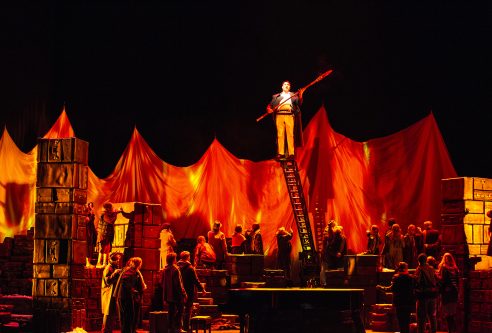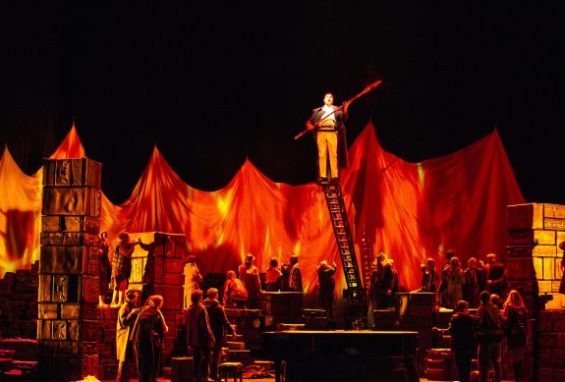 Germany Wagner, Die Walküre: Soloists, Orchestra of the Deutsche Oper Berlin / Nicholas Carter (conductor). Deutsche Oper Berlin, 12.5.2024. (MB)
Germany Wagner, Die Walküre: Soloists, Orchestra of the Deutsche Oper Berlin / Nicholas Carter (conductor). Deutsche Oper Berlin, 12.5.2024. (MB)

Production:
Director – Stefan Herheim
Revival director – Silke Sense
Set designs – Stefan Herheim, Silke Bauer
Costumes – Uta Heiseke
Video – William Duke, Dan Trenchard
Lighting – Ulrich Niepel
Dramaturgy – Alexander Meier-Dörzenbach, Jörg Königsdorf
Cast:
Siegmund – Daniel Frank
Sieglinde – Elisabeth Teige
Hunding – Tobias Kehrer
Wotan –Derek Welton
Fricka – Annika Schlicht
Brünnhilde – Ricarda Merbeth
Siegrune – Arianna Manganello
Rossweiße – Karis Tucker
Gerhilde – Felicia Moore
Ortlinde – Maria Motolygina
Waltraute – Elissa Pfaender
Helmwige – Flurina Stuckl
Schwertleite – Alexandra Ionis
Grimgerde – Nicole Piccolomini
Schwertleite – Lauren Decker
Hundingling – Eric Naumann
What if the Volsung twins did not engage our sympathies so fully as they usually do? What if their actions were less positive than we tend to think? Sometimes, recently, those questions have been posed implicitly by what still seems to me a strange desire positively to reassess the Fricka of Die Walküre. Not that Wagner is the only point of reference here, but the creator of the Ring was very clear on this, both in the work ‘itself’ and in other writing. A letter to Theodor Uhlig (12 November 1851, so before he had started work on the music) speaks of Wotan’s ‘struggle with his own inclination and with custom (Fricka)’ and indeed Fricka herself refers to ‘the guiding rope of custom, rent asunder,’ which she would ‘bind anew’. Latterly, some seem to have decided to take the part of Fricka’s family-values morality. Like every character – this is part of Wagner’s greatness – Fricka is given her due and should be in performance. A caricature, whilst tempting, will get us nowhere. What I took from the first act of Stefan Herheim’s Walküre – thus before her reappearance – was something slightly different: a willingness, refreshing if unsettling, to challenge the dominant narrative concerning Siegmund and Sieglinde, a challenge to which Fricka would assent, albeit for different reasons. Sieglinde has still been deeply wronged, of course: the evening begins with her, traumatised, unable to make the central stage piano sound. Only after several fruitless attempts does the orchestra launch its storm.
It is a questionable pursuit in ‘real life’, of course, to cast doubt on how trauma may manifest itself; perhaps the same should be the case here. That said, many of Siegmund and Sieglinde’s acts seem designed to dissipate sympathy, from her insistence on kissing him far too ‘early’ and in front of the mute Hundingling (her child with Hunding, I presume), to her murder of him who, starved of affection from his father seems only to wish to find a new family with his mother and her new lover. That Siegmund too rejoices in that act underlines the predicament. His holding Hunding earlier at knife point also reverses roles somewhat. Ultimately, the strength both of acting and Personenregie (seen also, for instance, in the individual treatment of the Valkyries) made a case for reassessment. So too, arguably, did the doubt – preconceptions properly challenged – I continued to feel. The framing is powerful and provocative; that is what matters most.
Likewise or at least related, in the third act, the true horror of what Wotan proposes for Brünnhilde, too readily sentimentalised, comes across more clearly than I can previously recall. Portrayal of male violence, especially sexual violence, against women onstage is a controversial issue now, and rightly so. Nevertheless, Herheim’s portrayal of Valkyries raped by a host of the undead – immortality and mortality a crucial theme for Wagner’s deeply Feuerbachian drama – underlines what the god intends for his ‘favourite daughter’, too often lost in final reconciliation. Indeed, this seemed to alter the dramatic, perhaps even the temporal, proportions of the third act. The latter probably were objectively different too, conductor Nicholas Carter working in tandem with the production. Throwing the dramatic weight forward had the first two scenes seem considerably more substantial, the third a logical, still deeply moving outcome to its predecessors. The emotional torrent of Wagner’s – and the once more outstanding Orchestra of the Deutsche Oper Berlin’s – strings still registered keenly, yet a shadow rightly hung over what we heard and felt.
All around, refugee suitcases formed the set, reminding us of the external world encountered in Das Rheingold. A war zone is suggested, aptly for all that unfolds, the second as much as the external acts. These people’s reappearance and different reactions to what they saw reminded us we should not take ‘their’ reactions for granted, ‘othering’ them as an undifferentiated mass. These, like the characters of the Ring many are playing, are individual human beings, not some other species known as ‘migrants’. Wagner was a refugee too and expressed pride in having been so; so is Siegmund, always ‘geächtet’, as he puts it. And so too, we should remember, is Sieglinde, returning to her Medea-like act. We always feel sympathy for Medea, so should we not for this Sieglinde too? If not, why not? From where, we might ask, are they refugees? The world around us has all too many possibilities, as does history. So too does reception history: might we not understand them also as heirs to the ‘men and women moved to the very depths of their being’ at the end of previous Ring productions. Celebrated predecessors such as Chéreau and Kupfer spring particularly to mind. For reception, always a Herheim speciality, continues to be so. The brilliant coup de théâtre of turning on the house lights when Wotan wills ‘das Ende’ may be old hat: Brecht, 1924, as a friend commented. But is that not the point here, that theatre and reception history more broadly contribute to what we see and hear, both when it conforms and when it does not? One could not want for alluring yet dangerous contrast in fire from lighting and video here either.

Carter’s direction continued to impress. If I found the opening Prelude hard-driven, then I often do; it could reasonably be replied that this is, after all, a storm. This conductor’s chemistry with the orchestra was not the least of this performance’s virtues; nor was careful shaping, without sounding unduly moulded, of paragraphs and scenes to form not only a satisfying musical whole, but one that interacts tellingly, excitingly with the action onstage. There are so many potential approaches to this music that it is perhaps impossible, even for a Furtwängler, to keep them all in the air. If, though, I sometimes missed the dramatic and dialectical despair conjured from the second act – that extraordinarily difficult yet crucial sequence – by the likes of Bernard Haitink or Daniel Barenboim, the sheer malevolence of the darker music associated not only with Hunding, but also with Wotan, was rendered strikingly immanent. It is a wonder, given the repeated telephone calls taken by someone in the far left of the stalls, that the Annunciation of Death managed to move at all, but it did. (It certainly had me devising my own such annunciation for whomever the culprit may have been.)
Herheim’s different conceptual approach to Siegmund and Sieglinde doubtless had consequences for perception of their performances. So too did relatively unappealing – especially so in Siegmund’s case – scenic presentation. That said, whilst Daniel Frank sang the role well enough, it did not seem to me the most keenly dramatic of performances, however considered. Elisabeth Teige engaged attention and sympathy more powerfully as time went on as his sister-bride. Tobias Kehrer’s Hunding seemed to me revisionist in an ultimately more convincing fashion, imparting deeper understanding of how and why even this most unsympathetic of characters might have turned out the way he did, without neglecting that he had. Derek Welton’s Wotan came across as perhaps more tightly, certainly more darkly, focused than that of Iain Paterson in Das Rheingold; that is perhaps in part a matter of material, but surely also pays tribute to the intelligence and musicality of this fine artist. At times, profoundly, disconcertingly other-worldly, the god could also readily turn human, all too human. Annika Schlicht’s Fricka was again not only beautifully sung, but verbally scrupulous, as here she must be all the more. From a fine complement of Valkyries, Ricarda Merbeth captured an excellent balance of waywardness – how could anyone delude himself she could for long be kept in check? – and growing compassion as Brünnhilde.
If, initially, I felt if not underwhelmed, then less overwhelmed than by the fizzing theatricality of Herheim’s Rheingold, this Walküre grew on me and has continued to do so. Music drama is, after all, not only theatre, as an increasingly Schopenhauerian Wagner would have been first to argue. At the close, Mime-as-Wagner returns, to deliver at the ‘right’ musical moment Siegfried from Sieglinde, collecting the shattered pieces of Nothung too. Both Mime and Wagner soon had their doubts as to what sort of monster they had created. That here they have done so from, as it were, the very spirit of music, the ever-present piano, will surely prove significant. Soon we shall discover for ourselves.
Mark Berry
